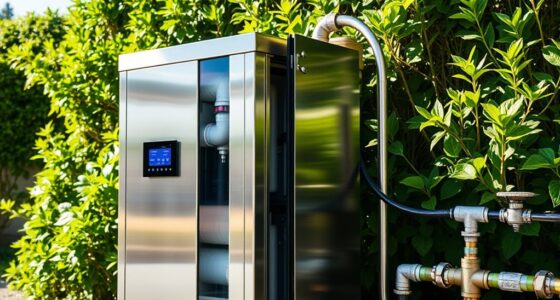If you’re looking to cut your energy bills, I recommend checking out some top whole-home energy monitors like the Emporia Vue 3, Leviton models, and Siemens Inhab. These devices offer real-time insights, support multiple circuits, and can integrate with your smart home setup. They help you identify high energy use and spot inefficiencies. Want to discover which monitor fits your home and needs? Keep exploring—there’s plenty more to learn.
Key Takeaways
- Choose monitors with multi-circuit support and real-time data to identify high-energy appliances and optimize usage effectively.
- Prioritize models with high accuracy (±2%) and long-term data storage for better energy management insights.
- Opt for easy DIY installation options, such as clamp-on sensors, to save on setup costs and time.
- Select compatible devices that integrate with your smart home platforms like Alexa, Google, or Home Assistant for automation.
- Consider safety certifications (e.g., UL Listed) and reliable customer support to ensure long-term, hassle-free operation.
Business 3-Phase Energy & Solar Monitor

If you’re managing a three-phase electrical system and want to optimize energy use, the Eyedro Business 3-Phase Energy & Solar Monitor is an excellent choice. It supports net metering, solar, and grid power monitoring, making it versatile for various setups. With high-resolution data collection 24/7, it tracks consumption, generation, power quality, and appliance spikes in real-time. Installation is simple using split core sensors, and connectivity options include WiFi or Ethernet. The included MyEyedro cloud platform offers detailed reports, cost estimates, and alerts—all at no extra subscription fee. This monitor helps identify inefficiencies and maximize renewable energy, saving money and improving system performance.
Best For: businesses, landlords, and homeowners seeking comprehensive, real-time monitoring of three-phase electrical systems with solar and net metering capabilities to optimize energy efficiency and reduce costs.
Pros:
- Supports multiple voltage configurations and solar/net metering, making it highly versatile for various system setups.
- High-resolution 24/7 data collection provides detailed insights into consumption, generation, and power quality.
- Easy, non-invasive installation with split core sensors and multiple connectivity options (WiFi or Ethernet).
Cons:
- Some users experience WiFi connectivity issues; Ethernet connection may be more reliable.
- Customer support and documentation quality vary, with some users reporting challenges.
- The product’s price and features may be somewhat complex for basic monitoring needs or small-scale systems.
Emporia Vue 3 Home Energy Monitor

The Emporia Vue 3 Home Energy Monitor stands out as an ideal choice for homeowners seeking exhaustive, real-time energy management across their entire house. It’s UL Listed, ensuring safety and reliability, with components tested to prevent hazards like overheating or fires. Installation is straightforward, using clamp-on sensors compatible with most systems, including single-phase and 2-wire setups. It offers 24/7 Wi-Fi monitoring with ±2% accuracy, providing instant data and cloud storage for detailed analysis. With features like automation, notifications, and precise appliance monitoring, it helps you optimize energy use, cut costs, and better manage your solar power and demand response efforts.
Best For: homeowners seeking comprehensive, real-time energy monitoring and control across their entire household with easy installation and robust safety features.
Pros:
- UL Listed, ensuring safety and compliance with North American standards
- Supports a wide range of electrical systems with optional sensors for complex setups
- Provides accurate, real-time data with cloud storage and customizable automation features
Cons:
- Requires Wi-Fi (2.4 GHz) for monitoring, which may be problematic in weak signal areas
- Additional sensors (sold separately) are needed for multi-wire or three-phase systems, increasing initial cost
- Limited to a 1-year warranty, which may be shorter than some competitors
Leviton Whole Home Energy Monitor with CTs
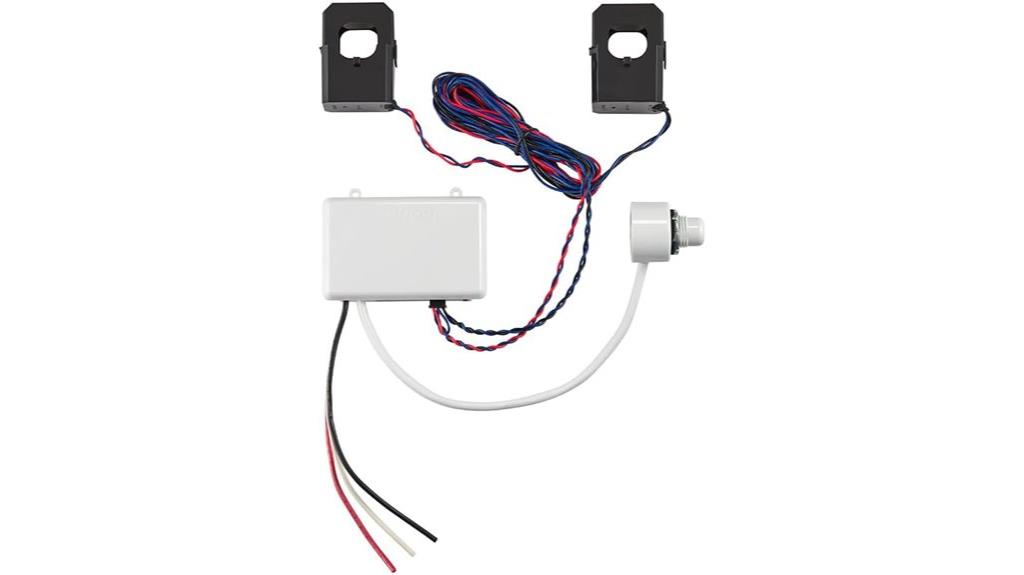
Looking for a reliable way to monitor your entire home’s energy consumption in real time? The Leviton Whole Home Energy Monitor with CTs is an excellent choice. It integrates seamlessly with your Leviton Load Center and provides real-time data via the My Leviton app. You can remotely control circuits, set schedules, and update firmware over Wi-Fi. Plus, it works with smart home devices like lighting and EV chargers, and can even prioritize critical circuits during backup power. With its all-encompassing monitoring and control features, it helps you optimize energy use, reduce costs, and enhance your home’s automation effortlessly.
Best For: homeowners seeking comprehensive, real-time energy monitoring and automation control for their entire home to optimize efficiency and manage smart devices easily.
Pros:
- Seamless integration with Leviton Load Centers and a wide range of smart home devices
- Remote monitoring, control, and firmware updates via Wi-Fi through the My Leviton app
- Ability to prioritize critical circuits during backup power, enhancing reliability and energy conservation
Cons:
- Requires compatible Leviton Load Center and potentially additional components for full backup power integration
- Setup and configuration may be complex for users unfamiliar with home electrical systems
- Limited compatibility with non-Leviton smart home ecosystems or third-party automation platforms
Smart Home Energy Monitor with Circuit Sensors and Real-Time Tracking
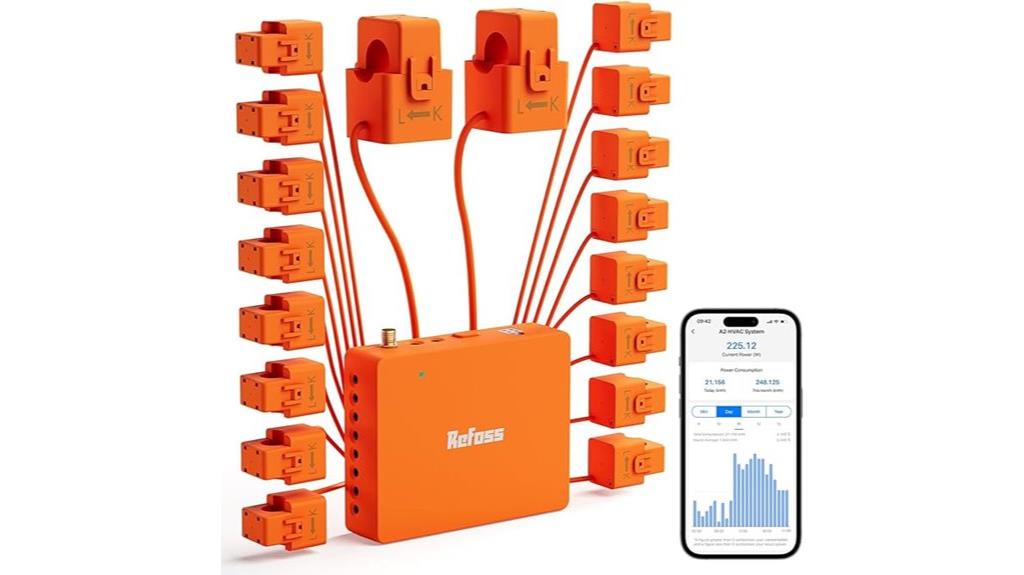
Homeowners seeking precise, real-time energy data will find the Refoss Smart Home Energy Monitor an excellent choice. It supports two main circuit sensors (up to 200A each) and 16 branch circuit sensors (up to 60A each), making installation straightforward with its clamp-on design. Compatible with various systems, it tracks energy consumption, solar output, and integrates with Home Assistant for centralized control. The device offers 98% accuracy, stores data for three years, and allows detailed viewing by time period. With features like real-time alerts, energy targets, and solar automation, it helps optimize usage and maximize solar benefits, all without relying on cloud services.
Best For: Homeowners and small business owners seeking accurate, real-time energy monitoring, solar optimization, and centralized control without reliance on cloud services.
Pros:
- Supports multiple circuits with high current capacity, ensuring comprehensive monitoring.
- Stores and displays detailed energy data for up to three years, aiding long-term analysis.
- Features real-time alerts and automation for optimizing energy use and maximizing solar benefits.
Cons:
- Installation requires handling current transformers carefully to prevent damage.
- No cloud or API support, limiting remote access outside the local network.
- Firmware updates and configuration may require app updates and some technical knowledge.
SIEMENS Inhab Smart Home Energy Monitor
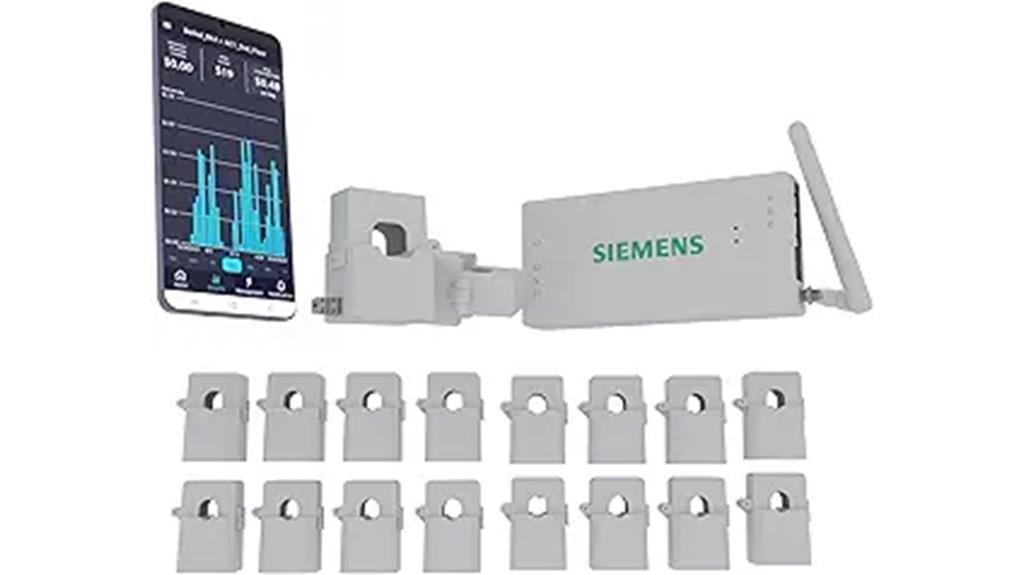
If you’re seeking a thorough energy monitoring solution that offers precise circuit-level insights, the SIEMENS Inhab Smart Home Energy Monitor is an excellent choice. It features sensors for 16-50Amp circuits and main sensors up to 200Amps, providing real-time data on home energy use. The device tracks energy consumption at both the panel and circuit levels, supporting up to 16 circuits without assumptions. Paired with a mobile app, it delivers 24/7 monitoring, alerts for unusual activity, and personalized energy-saving tips. With advanced features like peak demand management and load shedding, it helps optimize efficiency and cut costs, all while meeting strict safety and industry standards.
Best For: homeowners and property managers seeking comprehensive, real-time circuit-level energy monitoring and management to optimize efficiency and reduce costs.
Pros:
- Provides detailed real-time data at both panel and circuit levels for precise energy tracking
- Supports advanced energy management features like peak demand control and load shedding
- Compatible with a mobile app for 24/7 monitoring, alerts, and personalized tips
Cons:
- May require professional installation for optimal circuit sensor placement
- Limited to the USA and Canada markets, reducing accessibility in other regions
- The setup and configuration could be complex for users unfamiliar with electrical systems
Smart Home Energy Monitor with 16 Circuit Level Sensors
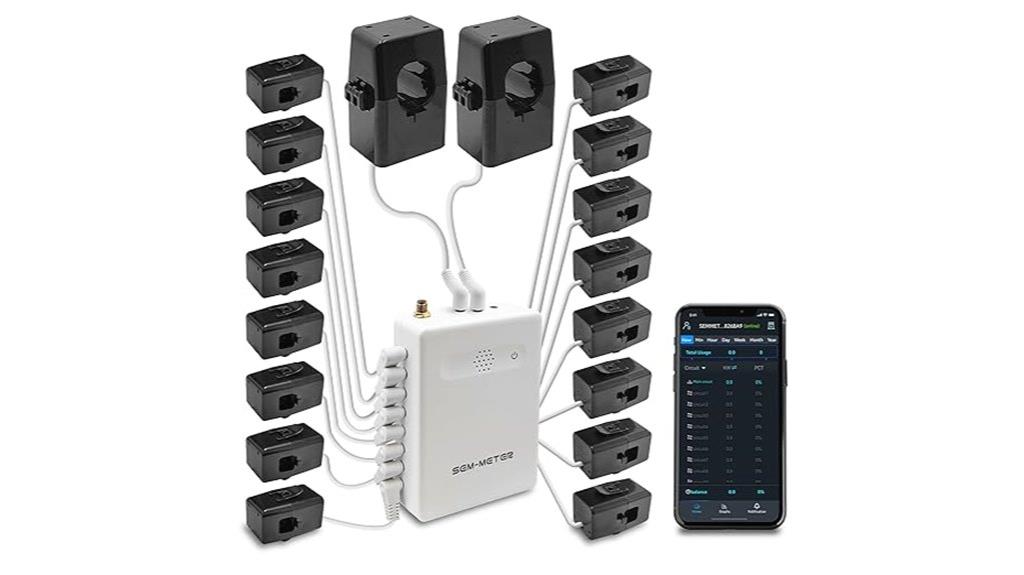
The Smart Home Energy Monitor with 16 circuit level sensors is ideal for those who want detailed, real-time insight into their entire home’s energy use. It measures power consumption in real-time and provides historical data through a user-friendly app. Compatible with Home Assistant, it supports various electrical systems, including single-phase, split-phase, and three-phase setups. Installation is straightforward with clamp-on sensors, even in panels with limited access. This monitor helps identify high-energy appliances, optimize usage, and reduce bills. Plus, with options for local control and privacy, it offers a secure, all-encompassing way to manage your home’s energy efficiently.
Best For: homeowners and energy enthusiasts seeking detailed, real-time monitoring and management of their entire home’s energy consumption for cost savings and environmental responsibility.
Pros:
- Provides comprehensive real-time power monitoring with 16 circuit sensors for detailed insights.
- Compatible with popular smart home platforms like Home Assistant and supports local control for enhanced privacy.
- Easy to install with clamp-on sensors suitable for various electrical system configurations.
Cons:
- Requires flexible sensors for panels with limited access, which may add to initial setup complexity.
- No support for Delta three-phase systems, limiting compatibility in some commercial or industrial applications.
- Data export and reporting features may require familiarity with app interfaces or additional configuration.
Emporia Energy Monitor with Sensors & Smart Plugs Bundle
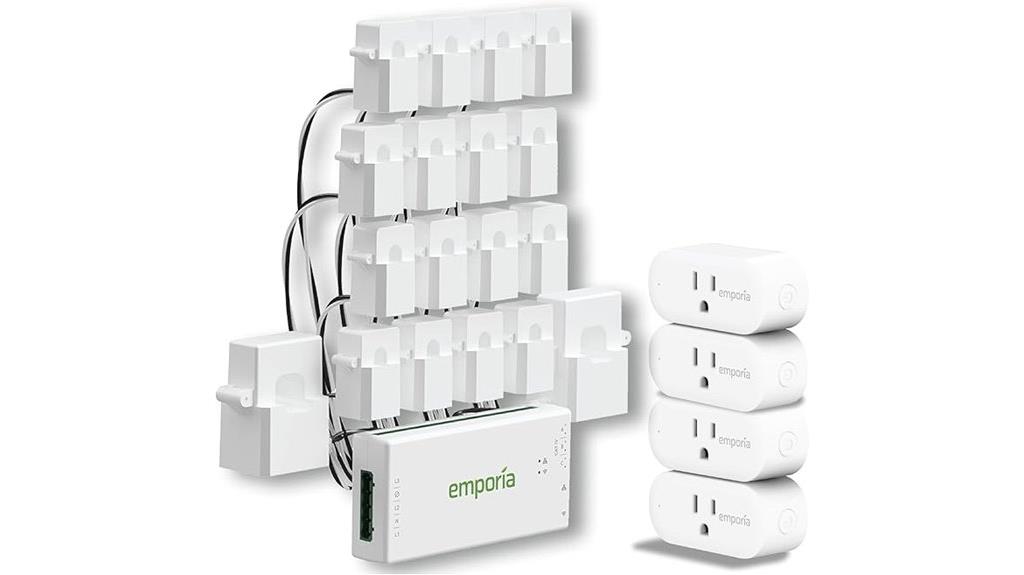
The Emporia Energy Monitor with Sensors & Smart Plugs Bundle is ideal for those seeking full visibility and remote control over their entire home’s energy consumption. It includes a Vue Energy Monitor with 16 sensors, allowing me to track the main panel and individual circuits in real-time. I can also control four smart plugs remotely, view their energy use, and automate devices to save power. The system integrates with iOS, Android, and Alexa, making management seamless. Using the free app, I analyze trends, set automations, and optimize my energy use for cost savings, all while securely accessing data from anywhere.
Best For: homeowners and energy-conscious individuals seeking comprehensive, real-time energy monitoring and remote control of their entire home.
Pros:
- Provides detailed monitoring of main panel and individual circuits with 16 sensors for comprehensive energy insight
- Supports remote control of four smart plugs with real-time energy usage data and automation capabilities
- Seamlessly integrates with iOS, Android, and Alexa for easy management and smart home compatibility
Cons:
- May require technical setup and familiarity with smart home systems for optimal use
- Limited to four smart plugs for remote control, which might not cover all devices needing automation
- Dependence on internet connectivity for cloud data access and automation features
Emporia Vue 3 Commercial Smart Energy Monitor
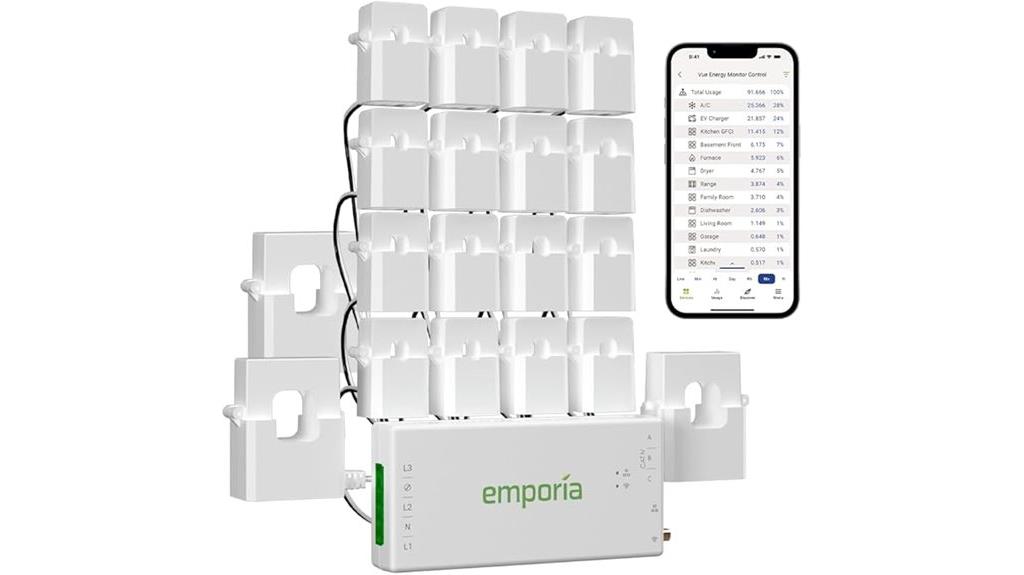
Designed for both small businesses and home automation enthusiasts, the Emporia Vue 3 Commercial Smart Energy Monitor stands out with its ability to support complex electrical systems, including 3-phase and 4-wire wye configurations. It uses clamp-on sensors to measure real-time usage across multiple circuits, providing insights into power consumption, solar generation, and net metering. Installation involves mounting in circuit panels, often requiring some electrician help due to its size and wiring complexity. While it offers accurate, general-purpose data via a user-friendly app, it lacks lab-grade precision and detailed voltage logging. Overall, it’s a versatile, cost-effective solution for monitoring larger systems.
Best For: small business owners and home automation enthusiasts seeking a versatile, cost-effective energy monitoring solution for complex electrical systems.
Pros:
- Supports a wide range of electrical systems including 3-phase and 4-wire wye configurations.
- Easy-to-use app provides real-time data on power consumption, solar, and net metering.
- Allows installation in circuit panels with minimal wiring required, especially in recent models.
Cons:
- Large size and multiple connectors may require professional installation and limit panel compatibility.
- Calibration is not lab-grade, with potential measurement deviations up to ±15W.
- Lacks detailed voltage data in exports and does not support native web access or local API for advanced integration.
Sense Flex Home Energy Monitor
If you’re looking for a whole-home energy monitor that offers detailed insights into your electrical system, the Sense Flex Home Energy Monitor stands out. It combines Sense’s core monitoring with Flex sensors, supporting multiple circuits, solar, or generators. The device provides real-time data via iOS, Android, and web apps, helping you track usage, identify device activity, and improve efficiency. While installation can be complex, especially for non-experts, it accurately detects power spikes and device signatures over time. However, some users report setup challenges, inconsistent detection, and limited customer support. Despite these issues, it’s a powerful tool for those wanting in-depth energy insights.
Best For: homeowners and energy enthusiasts seeking detailed, real-time monitoring of their entire electrical system, including solar and generator integration.
Pros:
- Provides comprehensive real-time energy usage data accessible via multiple devices and platforms.
- Supports monitoring of multiple circuits, solar offset, and generator activity with AI learning device signatures.
- Enhances home security by alerting users to device malfunctions or devices left on.
Cons:
- Installation can be complex and challenging for non-experts, with some setup instructions being unclear.
- Inconsistent device detection and auto-identification issues, especially for dedicated circuits.
- Customer support is primarily via slow email communication, with limited responsiveness and no phone support.
Leviton LSMMA Smart Mains Metering Accessory
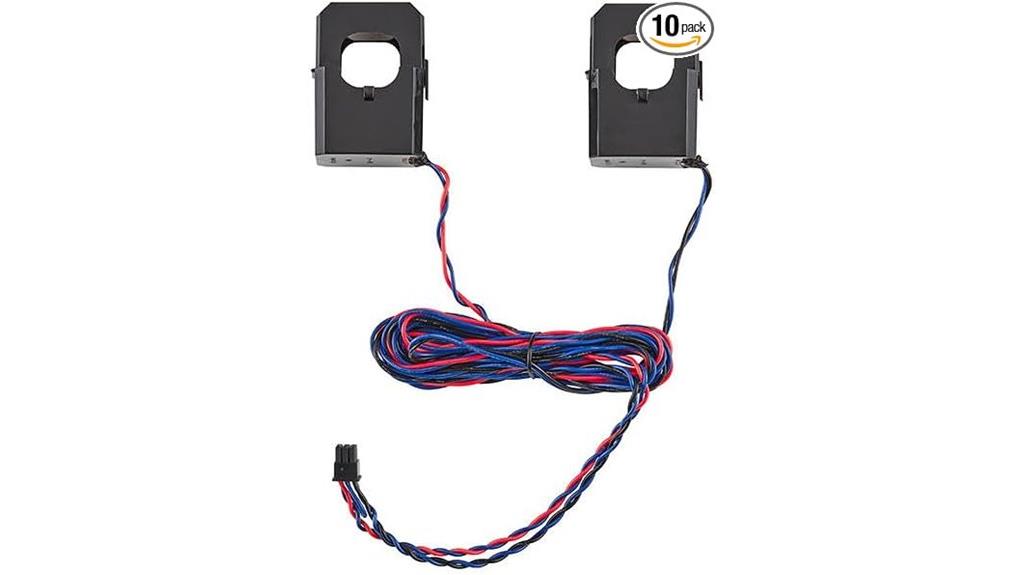
Homeowners looking to gain detailed insight into their energy consumption will find the Leviton LSMMA Smart Mains Metering Accessory to be an excellent choice, especially when used with the Leviton Load Center and Whole Home Energy Monitor. This accessory allows for real-time monitoring of energy flow from sources like the grid, solar, or batteries, supporting up to three pairs of CTs for exhaustive tracking. Its split-core design makes installation straightforward, clipping onto conductors at service mains or circuit breakers. Integrated with the My Leviton app, it offers a unified view of your home’s energy use and generation, helping you identify efficiency opportunities and save on costs.
Best For: homeowners seeking comprehensive real-time energy monitoring and management of multiple energy sources through a user-friendly interface.
Pros:
- Supports monitoring of multiple energy sources simultaneously with up to three pairs of CTs.
- Easy installation due to its split-core design that clips onto conductors at service mains or circuit breakers.
- Seamless integration with the My Leviton app for unified control and analysis of energy consumption and production.
Cons:
- Requires the Leviton Load Center and Whole Home Energy Monitor (LWHEM-2R) for full functionality.
- Limited to use with Leviton systems, which may restrict compatibility with other brands.
- Does not include batteries, relying entirely on the system power for operation.
Home Energy Monitor (EYEDRO-HOME) with WiFi or Ethernet

The Eyedro Home Energy Monitor (Model EYEDRO-HOME) is an excellent choice for those who want real-time, detailed insights into their household energy use. It supports WiFi or Ethernet connectivity, making setup simple—just connect sensors around your main breakers, plug in, and scan your network. The device provides instant data on watts, amps, volts, and costs, plus bill estimates and appliance spike detection. Its web interface is mobile-friendly, offering extensive dashboards and reports. Designed for North American 120VAC power, it’s ideal for DIY installation and detailed energy tracking, helping you identify high-consuming devices and optimize your home’s efficiency effortlessly.
Best For: DIY homeowners and energy-conscious users seeking real-time, detailed insights into household energy consumption to optimize efficiency and reduce costs.
Pros:
- Easy installation with minimal tools required, suitable for DIY setup.
- Supports both WiFi and Ethernet connectivity for flexible setup options.
- Provides comprehensive real-time data, detailed reports, and energy insights through a mobile-friendly web interface.
Cons:
- Occasional connectivity issues with website login can disrupt data access.
- No indicator lights on the device, which may make troubleshooting more difficult.
- Some users report inconsistent dial meter readings, requiring calibration or manual adjustments.
Smart Home Energy Monitor with Circuit Sensors and WiFi
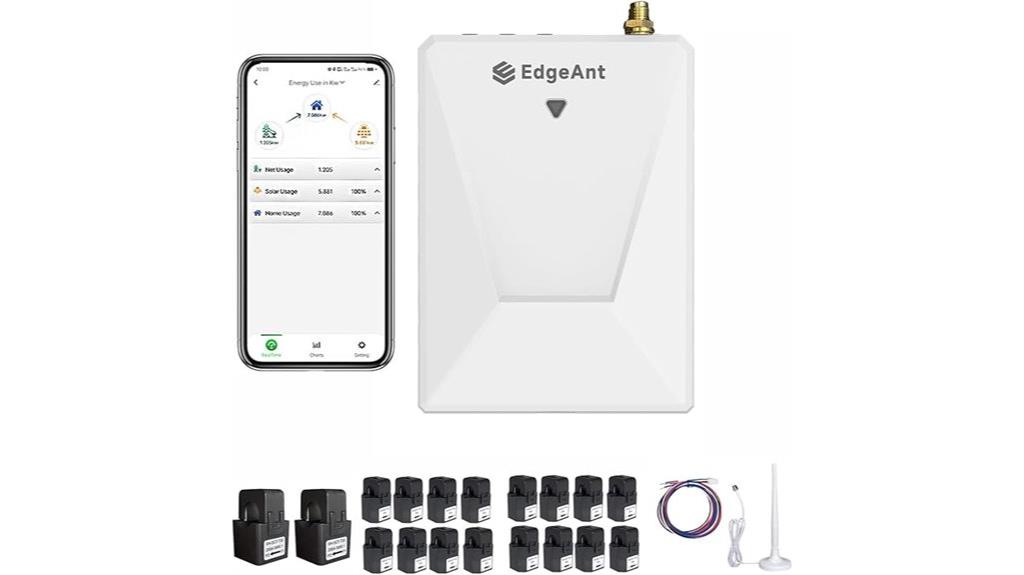
For those seeking detailed, real-time energy insights across their entire household, the Smart Home Energy Monitor with circuit sensors and WiFi stands out. It uses 16 50A sensors and 2-200A circuit-level sensors to track appliances like air conditioners, water heaters, and dryers accurately. Connecting via 2.4 GHz WiFi and compatible with Tuya, the device offers easy remote monitoring through a user-friendly app. With ±2% measurement accuracy and bidirectional data, it’s ideal for solar and grid management. Installation is straightforward, often within 30 minutes, especially with professional help. It provides instant updates on energy use, helping me identify inefficiencies and save on bills effectively.
Best For: homeowners and energy-conscious individuals seeking detailed, real-time insights into their household energy consumption and solar management.
Pros:
- Accurate measurement with ±2% precision, supporting real-time monitoring and bidirectional data for solar and grid integration.
- Easy to install and set up, often within 30 minutes, with user-friendly app control and compatibility with Tuya, Alexa, and Home Assistant.
- Provides comprehensive data on voltage, current, power factor, and energy use, helping identify inefficiencies and save on utility bills.
Cons:
- Limited software features, such as basic charting and lack of detailed time-of-use rate customization.
- Installation can be complex for some users, requiring professional help and careful wiring.
- Sensors may detect negative values if installed incorrectly, which can lead to confusing data unless properly configured.
Factors to Consider When Choosing Whole‑Home Energy Monitors

When selecting a whole-home energy monitor, I look at how well it matches my electrical system and how easy it is to install. I also consider how accurate the data is and what monitoring features are available to help me understand my usage. finally, I check if it integrates smoothly with my existing smart devices for seamless control.
Compatibility With Electrical Systems
Selecting a whole-home energy monitor requires guaranteeing it matches your home’s electrical system configuration. First, verify whether your system is single-phase, split-phase, or three-phase, so the monitor can accurately read your circuits. Next, check if it supports your voltage levels, such as 120V, 208V, or 240V, to ensure proper operation. Also, confirm that the sensors are rated for your circuit’s amperage—whether 50A, 200A, or 400A—to deliver precise measurements. Additionally, make sure the device can connect to your electrical panel type, whether via clamp-on, split-core sensors, or direct wiring. Lastly, confirm support for your wiring arrangements, like Wye, Delta, or high-leg Delta configurations, for extensive monitoring.
Installation Complexity Level
The installation complexity of whole-home energy monitors can vary considerably depending on the device and your electrical setup. Some models are straightforward, using plug-and-play clamp-on sensors that don’t require disconnecting power or opening panels. These are ideal for DIY installation and usually involve mounting sensors around existing breakers. More advanced systems, especially those for three-phase systems or solar integrations, involve more complex wiring and may require additional sensors, which can be challenging to install and configure. Certain monitors also need calibration after setup to ensure accurate readings, adding to the installation time and effort. Overall, some systems are simple to install with minimal tools, while others demand technical skills or professional help. Your choice depends on your comfort level and the complexity of your electrical system.
Data Accuracy and Precision
Selecting a whole-home energy monitor requires careful attention to data accuracy and precision, as these factors directly influence the reliability of the information you receive. High accuracy ensures measurements are within about ±2%, giving you dependable data to track your energy use effectively. Precise readings are vital for spotting small loads and appliance start-up spikes, which can considerably impact your energy management. Calibration procedures and sensor quality play a major role in maintaining measurement precision, especially in complex electrical systems. Over time, consistent accuracy depends on the monitor’s ability to stay calibrated and adapt to system variations. Accurate data empowers you to make smarter decisions about conserving energy, saving costs, and integrating renewable sources, making the monitor an essential tool for effective energy management.
Monitoring Features Offered
When evaluating whole-home energy monitors, it’s essential to take into account the range of monitoring features they offer, as these capabilities directly impact how effectively you can track and manage your energy use. Many monitors provide real-time data updates with high precision, often within ±2% to ±5%, ensuring accurate insights into your power consumption and system performance. Some models include circuit-level detection through multiple sensors, allowing you to identify energy use at the appliance or circuit level for targeted efficiency improvements. Advanced features like historical data logging, customizable alerts for abnormal activity, and integration with smart home systems or APIs enable automation and remote monitoring. Additionally, support for various rate structures helps you analyze costs based on your utility’s billing schemes, promoting smarter energy decisions.
Integration With Smart Devices
Choosing a whole-home energy monitor that seamlessly integrates with your existing smart devices can substantially enhance your energy management. Compatibility with popular platforms like Alexa, Google Assistant, or Home Assistant makes controlling and automating your energy use simple and intuitive. Support for Wi-Fi or Zigbee protocols guarantees reliable connectivity with your smart home network, enabling centralized monitoring and control. Integrating with smart meters, energy management systems, or automation routines allows you to optimize energy consumption based on real-time data and your preferences. Compatibility with smart switches, outlets, and appliances provides remote control and automation at the device level. Additionally, open APIs or support for custom firmware offer advanced users the flexibility to develop personalized automation workflows or connect with third-party systems, maximizing your energy efficiency.
Cost and Value Considerations
Evaluating the cost and value of a whole-home energy monitor is essential to guarantee you’re making a smart investment. I recommend comparing the monitor’s features to its price to ensure it offers good value. Think about the long-term savings potential through energy reduction and efficiency improvements the device enables. Also, consider any ongoing costs, such as subscription fees for cloud services or software updates, and weigh them against the initial purchase price. If a monitor offers advanced features like solar monitoring or circuit-level tracking, ask whether these justify a higher price. Ultimately, I look for a balance between affordability and the depth of data insights provided, so I can manage my energy use effectively without overspending.
Frequently Asked Questions
How Do Whole-Home Energy Monitors Integrate With Existing Smart Home Systems?
When I look at how whole-home energy monitors integrate with smart home systems, I see they often connect via Wi-Fi or Zigbee. I can easily sync them with platforms like Alexa, Google Home, or Apple HomeKit. This allows me to monitor energy use through my existing setup, set automation, and get real-time updates. It’s seamless, making managing my energy consumption simple and efficient.
Can Energy Monitors Detect Specific Appliance Energy Consumption?
Sure, I can tell you about that. Energy monitors can often identify specific appliances by analyzing their unique energy signatures, especially with advanced features like machine learning. I’ve seen some monitors that can distinguish between a refrigerator and a heater, giving you detailed insights. This helps me pinpoint which devices use the most energy, so I can make smarter choices and save money on my bills.
What Are the Installation Requirements for Different Energy Monitor Types?
Oh, installation requirements—because nothing says fun like wrestling with wires and deciphering vague instructions. For smart monitors, you often just need to clip a sensor onto your breaker panel; some require a professional. Non-intrusive models usually stick or plug into outlets, making life easier. Just remember, more complex systems might ask for a bit of electrical know-how—or a patient electrician friend. Either way, be prepared!
How Accurate Are These Monitors in Tracking Real-Time Energy Use?
When I look at how accurate these monitors are in tracking real-time energy use, I find they’re generally quite reliable, especially higher-end models. They provide near-instant updates and can detect small changes in consumption. However, some discrepancies can occur due to installation issues or device limitations. Overall, I’d say they give a good snapshot of your energy habits, helping you make smarter, cost-saving decisions.
Do Energy Monitors Provide Insights to Help Reduce Electricity Costs Effectively?
I believe energy monitors do provide valuable insights that can help reduce electricity costs effectively. By showing real-time usage, I can identify which appliances are the biggest energy hogs and adjust my habits accordingly. They also help me spot standby power leaks and schedule more efficient usage. Overall, these monitors empower me to make smarter decisions, ultimately saving money and reducing my environmental impact.
Conclusion
Choosing the right whole-home energy monitor can save you money and help you understand your energy habits better. It’s all about finding the perfect fit for your home and needs. Remember, a penny saved is a penny earned, so don’t overlook the importance of good energy management. With the right monitor in place, you’ll be well on your way to making smarter, more efficient choices—your wallet and the planet will thank you.





